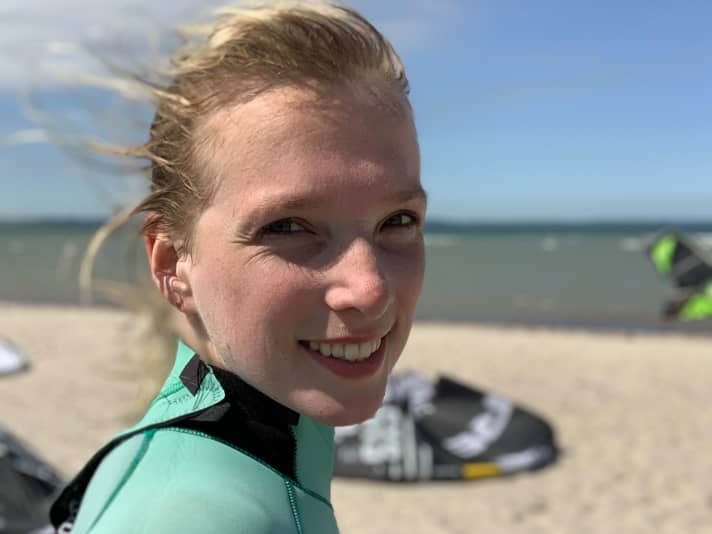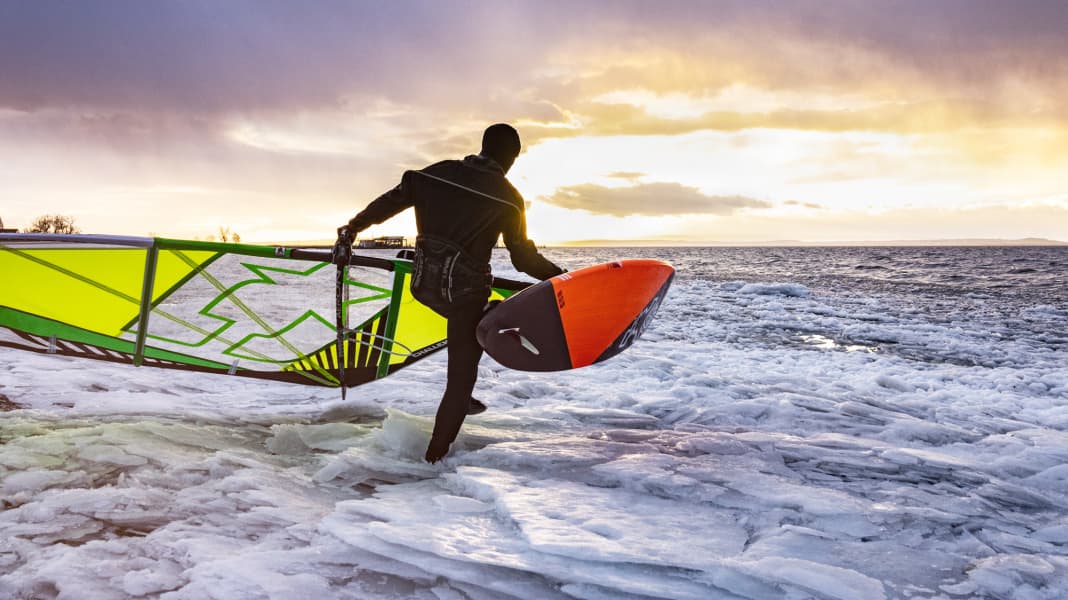Some people mothball their surf gear from October to April, while others take every opportunity to get out on the water in winter - and sometimes get the wrong looks when they plunge into the local waters when temperatures are in the single digits or even lower. However, many surfers who take to the water all year round rave about unforgettable sessions when hardly anyone else is thinking about water sports. Isn't windsurfing or wingfoiling in the cold harmful? We asked Dr Thomas Gangl and Dr Kirsten Thünemann from the Surfmedizin e.V. association - both of whom are also keen winter surfers!
If you pack your stuff in the car and set off at this time of year, a lot of people who aren't in the know will think you're crazy. Would you generally advise against surfing in winter?
Thomas: No, that's not a problem, it's similar to skiing - which is done in sub-zero temperatures and with a headwind. Nobody is advised against it, and nobody goes skiing in a swimming costume. The same applies to windsurfing: With the appropriate insulating clothing - i.e. a good winterneo - there is nothing wrong with that. The external conditions must of course be suitable, i.e. not in poor visibility, in offshore winds or with too strong a current.
Is there any limit beyond which you say it's better not to do it?
Thomas: In principle, as long as the water isn't frozen, you can surf. However, below zero degrees you can quickly get frostbite, which is accelerated by the wind chill. And very important: the body temperature must be kept constant, and that costs energy - the colder, the more. As I said, the right equipment is crucial, i.e. suit, shoes, gloves and bonnet. Maybe I'll wear a buoyancy waistcoat in winter for safety, even if I go without one in summer, and then maybe a small emergency transmitter (PLB, personal locator beacon) to send a signal in an emergency. But it shouldn't come to that, the important thing is not to push yourself to the limit on days like this and to judge your strength well.
As long as the water isn't frozen over, you can also surf."
Kirsten: I think the limit for windsurfing depends on many individual factors. Some people feel cold at 15 degrees, others at 5 degrees. If you normally only go windsurfing in Egypt, then in Germany you're already beyond your personal pain threshold at temperatures above 0 degrees. And the sessions naturally get shorter and shorter in winter, which is self-limiting at some point if the set-up and dismantling takes longer than the surf session itself.
Thomas: As soon as you realise "I'm getting chilly", you should take a break and warm up again thoroughly, for example in the caravan. You have to realise that you won't be on the water for five hours in these conditions or be able to do a new trick. The colder it gets, the worse your mobility becomes, your muscles become stiffer and you become more sluggish. It is important not to ignore such symptoms. Then there's nothing to stop you from surfing in winter.

Some people fear long-term damage from surfing in winter, such as joint problems or gout. Do you have any experience of this or can you give the all-clear?
Thomas: No, those are myths. Then there would have to be many more joint diseases in every other winter sport or among people who live in colder regions. Cold can exacerbate the symptoms of pre-existing metabolic diseases or signs of joint wear and tear, but it is not the cause of joint damage.
Are there any other immediate health risks if you get too cold?
Thomas: What many people don't realise: Cold damage to the skin (feet, hands, face) can occur even at plus degrees! At the latest when the skin turns white and numb, you should take a break to warm up to avoid permanent tissue damage.
There is no increased risk of catching a cold in healthy people."
There is no increased risk of catching a cold in healthy people, even if the cold puts a strain on the immune system. The majority of colds in winter are caused by contact with people who are already ill, for example at work.
Are there also positive effects, does surfing in the cold toughen you up?
Thomas: Basically, there are two types of hardening: one is against the cold, so that you no longer perceive the cold stimulus as much, get used to it and become less sensitive. But you have to be careful because this doesn't prevent hypothermia. In the long term, cold stimuli can increase the so-called "brown" fat in the body, which can generate heat. But it is impossible to say how much longer we can stay on the water as a result.

And the other is the immune system, which we can "toughen up": this can be done by alternating between hot and cold, for example when showering or in the sauna, which has been proven to strengthen the immune system. But you have to do this regularly to avoid catching a cold or something. Just surfing in the cold doesn't work....
What has been proven, however, is that the more muscle mass you have, the higher your basal metabolic rate and the more your body can warm itself up. So if you are well trained muscularly, you cool down less quickly than someone who is very thin and has little muscle mass. This is particularly noticeable in the long term; it won't work this winter...
And you've just hinted at it a bit, so you also go surfing in winter?
Kirsten: Yes, I go out on the water regularly - in winter I tend to go kitesurfing, because the high gripping resistance of the gloves would cause my hands to open up on the boom after a short time when windsurfing. I don't have that problem on the bar when kiting. Winter neo, thick neoprene gloves and 7 millimetre neoprene shoes are an absolute must for me in winter.
Thomas: I also tend to go kitesurfing or wingfoiling in winter. With thick gloves and shoes I have no feeling when windsurfing, and without them my fingers and toes freeze after a short time. I don't have to grip so tightly when kitesurfing and wingfoiling, it's fine.
If you get cold or start shivering, you should drive back inside. That's a warning signal."
Theoretically, you could surf indefinitely in winter if you don't lose any heat. But even if you are completely wrapped up, you still lose heat through your skin, face, breathing and the surrounding air, and if your body can no longer compensate for this through movement, then your body temperature drops. This starts with shivering or getting cold, and that would actually be a warning signal that you should get back inside. The only thing that helps is to take a break, warm up or go home and come back the next day. It's no fun if surfing is just exhausting and you're just trying to keep your head above water.
Do you have any "hot" tips for winter surfing from your own experience or from a medical perspective?
Kirsten: I can recommend neoprene mittens, which are available for windsurfers with an open palm for good grip on the boom. With these gloves, the fingers can warm each other. You also have to use less force when gripping the boom than with conventional neoprene gloves that are not pre-curved. The mittens provide the perfect combination of warmth and sensitivity, both of which are very important on the water.

Thomas: And my biggest tip is to go to the water "warm". That means preparing everything, getting out of the warm car wrapped up in winter clothes, getting everything ready on the beach, then warming up properly in the bus or car and, ideally, changing indoors. This way you might even go out a little overheated because it's too warm in the bus with neoprene, so you have an advance on warmth. That's better than changing beforehand and then setting up in your wetsuit on the beach in the wind and cooling down in the process.
You mention the topic of warming up. Some windsurfers do it, some don't at all. What is your advice?
Thomas: The question is always whether you don't actually start to cool down during the warm-up. It would be ideal to get your muscles going a bit on the bus, but the danger is that you unconsciously cool down again when you're walking around on the beach. You might have the feeling that you've been moving, but you've actually only lost energy in the process, which is then lacking in the water.
Thank you very much for the interview and have fun on the water!
This is Surf-Medizin e.V.
Surf Medizin e.V. was founded by surfing doctors specialising in sports orthopaedics and sports traumatology. The association aims to help prevent water sports injuries and improve the care of surfers of all disciplines. Surfmedizin e.V. trains water sports athletes and doctors to improve injury prevention and optimise safety concepts in surf camps and schools. Associations and athletes can obtain medical advice and find a specialised doctor or physiotherapist in their area. One current medical project is the Study on the risk of injury when wingfoiling.


